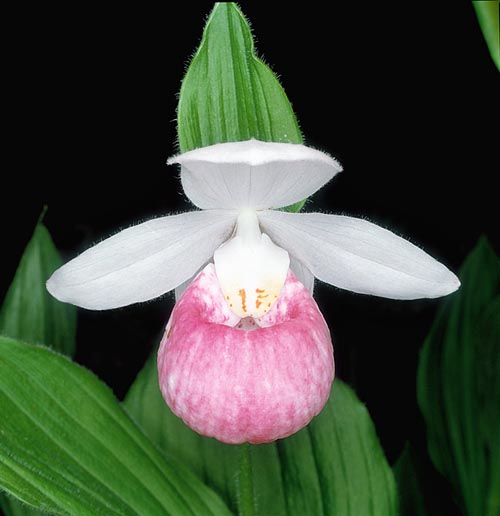Family : Orchidaceae

Text © Pietro Puccio

English translation by Mario Beltramini

The Cypripedium reginae is the largest North American spontaneous orchid © G. Mazza
The species is native to Canada (Manitoba, New Brunswick, Newfoundland, Nova Scotia, Ontario, Prince Edward Island, Quebec and Saskatchewan) and USA (Arkansas, Connecticut, Indiana, Iowa, Kentucky, Maine, Maryland, Massachusetts, Michigan, Minnesota, Missouri, New Hampshire, New Jersey, New York, North Carolina, North Dakota, Ohio, Pennsylvania, Tennessee, Vermont, Virginia and West Virginia), where it grows on usually calcareous soils at the margins of the humid forests, of swamps, in the ponds, meadows, prairies, dunes, hilly slopes, up to about 600 m of altitude, in zones characterized by cool and humid summers and winters even remarkably rigid.
The name of the genus is the combination of the Late Latin terms “Cyprius” = of Cyprus, one of the names of Venus, and “pedium” = slipper, sandal, with reference to the shape of the labellum; the name of the species is the genitive of the Latin term “regina” = queen.
Common names: Indian-shoe, pink moccasin flower, queen lady’s-slipper, queen slipper-orchid, royal lady’s-slipper, showy lady’s-slipper, white-petaled lady’s slipper (English); cypripède royal (French).
The Cypripedium reginae Walter (1788) is a deciduous terrestrial orchid, wholly covered by short glandular hairs, 40-90 cm tall, with a robust creeping rhizome and erect stem carrying 3-9 plicate leaves, alternate, ascending, of elliptic or ovate-lanceolate shape, 10-25 cm long and 6-16 cm broad, with wavy margin.
The inflorescence is terminal erect and carries 1-3 (rarely 4), flowers with pristine white sepals and petals, which highlight the labellum, usually bright pink with white striations; a completely white variety does exist.
The dorsal sepal is erect or ascending, ovate, 2,5-4,5 cm long and 2-4 cm broad, whilst the lateral ones are united for all their length to form, behind the labellum, a sort of a unique sepal (synsepal), 2,5-4,5 cm long and 1,5-3,5 cm broad; the petals are oblong or elliptic, 2,5-4,5 cm long and 1-1,5 cm broad, and finally, the labellum, sack-shaped, with curved margins, is 2,5-5 cm long and 1,5-3,5 cm broad. The fruits are ellipsoidal, 3-4 cm long, capsules and with a diameter of about 1,5 cm. It reproduces by seed, in vitro, and by division by the end of the resting period.
It is the biggest, and by many considered as the most ornamental, amongst the spontaneous North American orchids, of rather easy cultivation, if its cultivation exigencies are respected.
It requires a climate not differing from that of its origin places, with cool and humid summers, as it does not bear the high temperatures and the dry air, an exposition in full sun or slight shade, with at least 2-3 hours of direct sun per day, and neutral soil, or, better, slightly alkaline, light and perfectly draining, kept constantly humid; it suffers in compact or too clayey soils and decays in presence of water stagnations or of poor oxygenation at the roots level.
It may be cultivated in pot, not forgetting its exigencies, on a substratum which may be formed by alkaline peat, mould of leaves and calcareous sand in equal parts, caring particularly the drainage.
The Cypripedium reginae is the Minnesota state flower.
The contact with the leaves down may cause allergic reactions in particular sensitive subjects.
It is a protected species, at risk of extinction in many of its origin areas due to the excessive anthropization and the indiscriminate harvesting, which is, in any case, of no use, as the plants picked up in the wild rarely do survive.
The species is inscribed into the appendix II of the CITES (species whose trade is internationally ruled).
Synonyms: Cypripedium album Aiton (1789); Cypripedium spectabile Salisb. (1791); Cypripedium canadense Michx. (1803); Calceolus reginae (Walter) Nieuwl. (1913).
→ For general notions about ORCHIDACEAE please click here.
